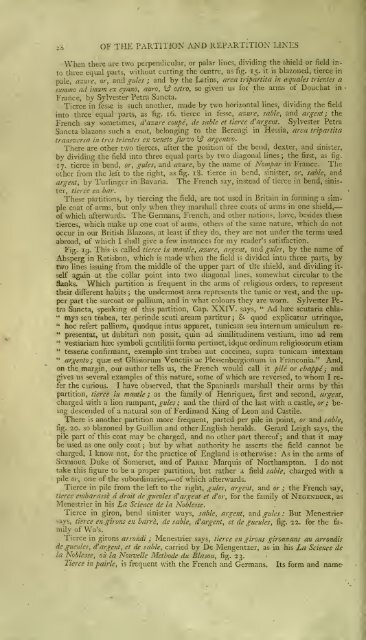A System of Heraldry - Clan Strachan Society
A System of Heraldry - Clan Strachan Society
A System of Heraldry - Clan Strachan Society
You also want an ePaper? Increase the reach of your titles
YUMPU automatically turns print PDFs into web optimized ePapers that Google loves.
3 -, OF<br />
THE PARTITION AND REPARTITION LINES<br />
When there are two perpendicular,<br />
or palar lines, dividing the shield or field into<br />
three equal parts, without cutting the centre, as fig. 15. it is blazoned, tierce in<br />
pale, azure, or, and gules ; and by the Latins, area in<br />
tripartite aquales trientes a<br />
summo (Hi irrium ex cyano, auro, fc? astro, so given us for the arms <strong>of</strong> Douchat in<br />
France, by Sylvester Petra Sancta.<br />
Tierce in fesse is such another, made by two horizontal lines, dividing the field<br />
into three equal parts,<br />
as fig.<br />
16. tierce in fesse, azure, sable, and argent; the<br />
French say sometimes, d''azure coupe, de sable et tierce $ argent. Sylvester Petra<br />
Sancta blazons such a coat, belonging to the Berengi in Hessia, area tripartita<br />
transversa in tres trientes ex veneto furvo IS argenteo. There are other two tierces, after the position <strong>of</strong> the bend, dexter, and sinister,<br />
by dividing the field into three equal parts by two diagonal lines ; the first, as fig.<br />
17. tierce in bend, or, gules, and azure, by the name <strong>of</strong> Noinpar in France. The<br />
other from the left to the right,<br />
as fig. 18. tierce in bend, sinister, or, sable, and<br />
argent, by Turlinger in Bavaria. The French say, instead <strong>of</strong> tierce in bend, sinister,<br />
tierce en bar.<br />
These partitions, by tiercing the field, are not used in Britain in forming a sim-<br />
ple coat <strong>of</strong> arms, but only when they marshall three coats <strong>of</strong> arms in one shield,<br />
<strong>of</strong> which afterwards. The Germans, French, and other nations, have, besides these<br />
tierces, which make up one coat <strong>of</strong> arms, others <strong>of</strong> the same nature, which do not<br />
occur in our British Blazons, at least if they do, they are not under the terms used<br />
abroad, <strong>of</strong> which I shall give a few instances for my reader's satisfaction.<br />
the name <strong>of</strong><br />
Fig. 19. This is called tierce in mantle, azure, argent, and gules, by<br />
Absperg in Ratisbon, which is made when the field is divided into three parts, by<br />
two lines issuing from the middle <strong>of</strong> the upper part <strong>of</strong> the shield, and dividing it-<br />
self again at the collar point into two diagonal lines, somewhat circular to the<br />
flanks. Which partition is frequent in the arms <strong>of</strong> religious orders, to represent<br />
their different habits ;<br />
the undermost area represents the tunic or vest, and the up-<br />
per part the surcoat or pallium, and in what colours they are worn. Sylvester Petra<br />
Sancta, speaking <strong>of</strong> this partition, Cap. XXIV. says, " Ad haec scutaria chla-<br />
" mvs seu trabea, ter perinde scuti aream partitur ; & quod explicatur utrinque,<br />
" hoc refert pallium, quodque intus apparet, tunicam seu internum amiculum re-<br />
" presentat, ut dubitari non possit, quin ad similitudinem vestium, imo ad rem<br />
" vestiariam haec symboli gentilitii forma pertinet, idque ordinum religiosorum etiam<br />
"<br />
tessenc conformant, exemplo sint trabea aut coccinea, supra tunicam intextam<br />
"<br />
argento; quoe est Ghisiorum Venetiis ac Plessenbergionum in Franconia." And,<br />
on the margin, our author tells us, the French would call it<br />
pile<br />
or chappe ; and<br />
gives us several examples <strong>of</strong> this nature, some <strong>of</strong> which are reversed, to whom I refer<br />
the curious. I have observed, that the Spaniards marshall their arms by this<br />
partition, tierce in mantle ; as the family <strong>of</strong> Henriquez, first and second, argent,<br />
charged with a lion rampant, gules ; and the third <strong>of</strong> the last with a castle, or; being<br />
descended <strong>of</strong> a natural son <strong>of</strong> Ferdinand King <strong>of</strong> Leon and Castile.<br />
There is another partition more frequent, parted per pile in point, or and sable,<br />
fig. 20. so blazoned by Guillim and other English heralds. Gerard Leigh says, the<br />
pile part <strong>of</strong> this coat may be charged, and no other part there<strong>of</strong>; and that it may<br />
be used as one only coat ; but by what authority he asserts the field cannot be<br />
oharged, I know not, for the practice <strong>of</strong> is England otherwise : As in the arms <strong>of</strong><br />
SEYMOUR. Duke <strong>of</strong> Somerset, and <strong>of</strong> PARRE Marquis <strong>of</strong> Northampton. I do not<br />
take this figure to be a proper partition, but rather a field sable , charged with a<br />
pile or, one <strong>of</strong> the subordinaries, <strong>of</strong> which afterwards.<br />
Tierce in pile from the left to the right, gules, argent, and or ; the French say,<br />
tierce embarasse d droit de gueules d' argent et d'or, for the family <strong>of</strong> NEGENDUCK, as<br />
Menestrier in his La Science de la Noblesse.<br />
Tierce in giron, bend sinister ways, sable, argent, and. gules : But Menestrier<br />
ys, tierce en girons en barre,<br />
mily <strong>of</strong> Wa's.<br />
de sable, d? argent, et de gueules, fig. 22. for the fa-<br />
Tierce in girons arrondi ; Menestrier says, tierce en girons gironnans au arrondis<br />
de gueules, d' argent, et de sable, carried by De Mengentzer, as in his La Science de<br />
la Noblesse, 011 la Nouvelle Metbode du Blason, fig. 23.<br />
Tierce in pairle, is frequent with the French and Germans, Its form and name-




